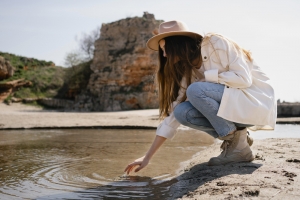In a world dominated by smartphones, tablets, and laptops, who even remembers how nature looks anymore? It's all about who can master ChatGPT and flex the latest iPhone – an expensive little device that could feed a family of 6 for at least two months. Where is nature, you'd ask? Well, it's still here, in all its glory, but we've become so distracted we hardly notice it.
Once upon a time, people would gaze at a stunning sunset and feel a wave of pure joy. Today? We're so glued to our screens that looking up at the sky feels like a monumental task. But what if we took a moment to break free from the digital maze and actually see the world around us? Imagine the sunsets, the rustling trees, and the simple beauty we've forgotten to appreciate.
This article aims to prove reconnecting with nature is easier than you think, offering delightful habits for bringing a little bit of the outdoors into your everyday life.
The importance of connecting with nature
If simply watching nature documentaries is proven to be good for our mental health, imagine the benefits of spending time in nature, lively admiring woodlands, forests, rivers, wetlands, beaches, and whatever other spectacular beauties nature has to offer. Spending time in nature can decrease your anxiety levels, lessen stress and feelings of anger, reduce cortisol levels and muscle tension, and lower heart rate and blood pressure.
Additionally, for those who have trouble falling asleep (like so many of us), exposing yourself to sunlight can help you feel more tired at night. The quality of your sleep is closely tied to your circadian rhythm, a natural cycle influenced not only by factors like food intake, stress, and social interactions but also by your exposure to sunlight and darkness. Light therapy is also suitable for seasonal and major depression, as SAD (Seasonal Affective Disorder) is linked to reduced sunlight exposure during winter months, making it imperative to spend more time in nature, especially when it's sunny outside.
Moreover, nature can evoke a creative way of thinking. Immersing yourself in the natural world has long been recognized as a catalyst for creative inspiration, as many artists are using this method. A simple walk in serene nature (sometimes enhanced by a glass of wine) can ignite creativity even in the most uninspired person in the world, becoming a universal recipe for souls who're trying to channel their creativity.
Practices that enrich and strengthen your relationship with nature
You might ask yourself: "What does keeping a strong connection with nature actually mean?"
Well, it's all about how you relate to and experience nature. You don't have to live in the wilderness like a monk dedicating your life to solitude. Simply listening to bird songs, feeling the roughness of tree bark, breathing in the scent of flowers, or even writing about your favorite nature spot can deepen your connection. Let's find out what are the most common practices used nowadays for cultivating a bond with nature!
Outdoor Meditation
The placement of monasteries and meditation centers in remote, natural settings like forests and jungles is indeed not arbitrary. These locations were mainly chosen for spiritual reasons, as nothing supports the opening of the heart and mind like the splendor, serenity, and stillness of the natural world. Whether you practice sound, nature observation, or sun meditation, Mother Nature gives you innumerable metaphors that you can learn from.
Meditation is a deeply personal journey, but while experiences differ, its core often involves connecting with nature intentionally and mindfully. You can start with basic nature meditation, and only after experiencing the countless alternatives, adapt each one to your feelings and senses.
Gardening
If you are seeking to embrace the whole of nature in its beauty, try gardening. From the soil in your hands to the sun in the sky, everything is interconnected. Feeling the soil between your fingers and planting bulbs in your thoughtfully chosen plant pots while constantly checking on nature's rhythms deepens your relationship with the environment, putting you in touch with nature in its myriad forms of life and death.
Getting started can feel a bit intimidating, as there are lots of things you need to care about, such as determining the orientation of your garden, improving soil quality, learning the proper planting season for each plant, buying essential tools, and adequately fertilizing your garden. As a beginner gardener, there is no need to invest in a full arsenal of tools right from the start. Begin with the basics - gloves, pruning shears, and watering wangs.
Moreover, gardening doesn't restrict you to planting outdoors, so you can bring the calming essence of nature into the comfort of your home whenever you want. Whether you plant a blooming orchid, a lush fern, or even a collection of succulents, at elho you can find a wide variety of planters, that you can choose according to your personal preferences: shape, size, design, and materials.
Silvotherapy
If you've ever walked into people who were tightly hugging trees, the following two questions were probably weighing on your mind:
- Are they under the influence?
- Is this a form of engaging in a profound connection with the natural world?
Hopefully, the second answer was correct, which means they were simply having a Silvotherapy session. This practice often lasts 20 to 40 minutes and involves connecting with nature on a deeper level by harnessing physical contact with trees. The curative properties of trees can be effortlessly shifted to you when you dedicate moments to recline against their trunks while sensing their unwavering presence and absorbing their peacefulness.
Final Thoughts
In a culture that actively tries to drive a wedge between you and nature, trying to destroy any spiritual connection that comes with it, it's essential to remember what matters most. Give up for a little bit on your designer shoes and walk barefoot instead; trust us, you'll survive!






